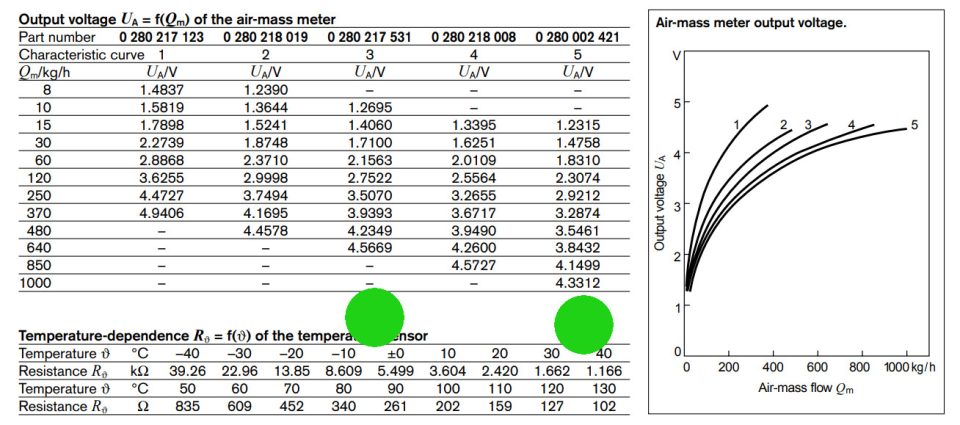1.8T MAF Upgrade – Is It Necessary?
September 25, 2024In our testing the Bosch MAF sensor found on 1.8T motors (codes 0 281 002 216, VW number 028 906 461, Bosch number 0 280 217 121, VW number 06A 906 461) may max out in housings with 80mm outside diameter @ 300bhp+. If you’re seeing 4.4v or higher as your MAF output voltage, it could be worth doing a 1.8T MAF upgrade.
Why Is 4.4 Volts a Problem?
Bosch give the characteristic output curve for their HFM5 MAF sensors here and http://www.auto-consulting.it/ have done an article giving a characteristic curve on Bosch MAF sensors here.
Both sources show the same/similar curves and show the resolution of the sensor dropping off a lot after 4.4 volts (and indeed Bosch stop the curve at 4.4 volts).

In our testing we found that the MAF might even be running into a hard limit at 4.4 volts ie it’s possible the sensor would not read more than 4.4 volts. Our datalogs showed the MAF sensor signal flat-lining at 4.4volts. There may be other reasons for this, but given Bosch only give the characteristics up to 4.4volts we thought it couldn’t hurt to use a bigger housing.
Again, this testing was done with an 80mm outside diameter.
In our opinion, it would be preferable to give the ECU as accurate information as possible about the air entering the engine. A bigger housing would mean the signal voltage changing more with flow change vs a smaller housing. This means the sensor giving better resolution at high flow rates.
How To Upgrade
There are two steps to upgrading the MAF sensor. The first is physically installing a bigger MAF housing, the second is calibrating the signal coming from the new housing.
1.8T MAF Upgrade – The Mechanical Part
To get more accurate data at higher loads, we can put the same MAF sensor element in a larger MAF housing, in our case we went from an 80mm outside diameter housing (I believe from a VR6) to a 90mm outside diameter housing from an RS4. This is the one we have.
With the larger housing, the same volume of air will move less air over the sensor (90mm housing versus 80mm), which means a lower output voltage for the same airflow, which means the MAF signal will have a higher resolution (because the voltage will change more for the same change in airflow).
With the MAF installed in the new housing, you then need to use hose reducers to get the 90mm diameter back down to the diameter of your intake piping. How you do this is entirely up to you. Read this article for the importance of MAF sensor placement.
1.8T MAF Upgrade – The Electrical Part
Simply moving the MAF sensor element from the stock MAF housing to the 90mm housing is not enough.
We also have to re-calibrate the MAF sensor signal so it is giving the engine ECU accurate data.
To do this we used our own product, MAF CAL.
MAF CAL alters the signal from new housing and sends it to the engine ECU.
In this case, because we have fitted a larger housing, at lower loads and lower RPMs we have to increase the signal from the MAF sensor before sending it to the engine ECU. The biggest corrections are at low airflow rates and as airflow over the MAF sensor increases, we gradually lower the increase we are making to the signal. For example at low flow rates maybe we are adding 10% to the MAF signal but at higher flow rates we are adding 3 or 4% for example.
To tune the adjustment we are making to the MAF sensor signal, we look at the Short Term Fuel Trims via OBD2. We want the fuel trims to be as low as possible and preferably less than 5%. If trims are positive, we need to add to the signal (add fuel) and vice versa. In this case, with the larger housing, the trims go positive with no adjustment.

